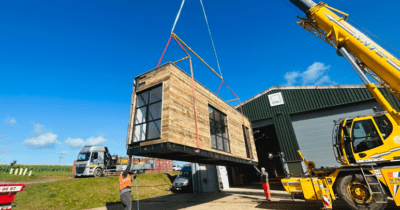Why Tiny Houses Are The Ultimate Solution For The Modern Age
Tiny houses aren’t new; people have been living in small spaces for as long as there have been people around. But in the last fifteen years the popularity of tiny houses in the West has skyrocketed.
The Youtube and social media sensation ‘Living Big in a Tiny House’ boasts over 4 million subscribers, and George Clarke’s ‘Amazing Spaces’ has just been renewed for its ninth season. Instagram and TikTok are brimming with how-to tips for tiny house living and this growing community shows no sign of slowing down.
Tiny House: Big Fix
Tiny house residents evangelise about the simple way that this type of small and beautifully designed living space allows them to ‘tread lightly’ on the earth, reduce their working hours, and spend more time enriching their lives with time spent on hobbies and with friends.
Arnold Schwarzenegger is the latest in a long line of celebrity endorsers who have been celebrating the elegant solutions that tiny houses can offer to people who want dignified, affordable, and sustainable homes. Even Elon Musk is a fan.
What is a Qube Eco Tiny Home?
Today, I am speaking with Jordan Spittle, Associate Director of The Qube to find out more about this family-run business and how tiny houses captured his heart too.

The Qube is a family owned and run business. It’s a small and personal set-up which lets everyone involved in the designing, building, and installation of each tiny house offer a bespoke and personal service to their buyers.
I spoke to Jordan early in February 2022 to learn more about what prompted this business idea in the first place.
“The Qube was formed in 2007 and focused on addressing a gap in the market for luxury garden studios; things like home offices, gyms, craft studios and things like that. Since then the company has grown in size and we have seen really high demand for our Modular Buildings in the education sector. Our clients use them as quick and eco-friendly extensions to their classrooms and teaching spaces”
Jordan goes on to tell me about the tiny houses they make.
“More recently, around the start of the Covid-19 pandemic, we set up a new offering in the business which focuses on designing and building tiny homes.
Personally, I have been interested in tiny homes for years. My fascination started through seeing them on Instagram. After that I watched a load shows and documentaries online and on Netflix.
That’s when I really started to notice that no single company in the UK seemed to be doing it as well as they are doing it over in Australia, The States or New Zealand. That’s how our partnership with Designer Eco Tiny homes, an Australian tiny house builder, was born.”
Sleek, hand-crafted design
The majority of people who buy tiny homes are doing it for lifestyle reasons. The movement is very values driven, which means that people who invest in a tiny house are doing it so that they can curate a more simplified, less cluttered, less frantic pace of life.
There isn’t a style-guide per se, but the aesthetic tends to be quite minimal just because of the available space.
Necessity is the mother of invention, and tiny houses showcase this perfectly. Thoughtful, functional design is top on the list of priorities for The Qube tiny homes. Smart storage is expertly integrated.
Jordan told me about the smart design solutions that are built into their own tiny homes.
“Storage is key and we have designed tiny homes with storage under the stairs, built wardrobes under mezzanine floors, designed fold-out tables which come out of the walls and kitchen counter tops that extend to form a breakfast bar. It’s all really smart and pretty impressive to see in action.”
Tiny home, tiny impact
The sustainability credentials of a tiny house are a hugely appealing factor for holiday let businesses, glamping sites, and for residential buyers.
And they’re right to get excited. Simply by using sustainably managed forests for the construction of these little timber tiny houses, the carbon burden of a home can be reduced by up to 69% compared to traditional builds.
This is big news for forward-facing housing developers and glamping businesses alike. Relying on wood for just half of new urban developments could accomplish almost 10% of our entire 2030 carbon emission goals.
Not only that, but once they’re built their small size means they use on average two-thirds less energy to heat and cool. In addition to bolstering the environmental credentials of a tiny house, this confers significant savings onto the inhabitants, an especially topical consideration at the moment when energy prices are soaring.
Many tiny house residents decide to fit solar panels, wind turbines, or use dry composting toilets in their homes. This level of energy efficiency, cost savings, and shrinking of your personal carbon footprint is almost impossible to achieve in a traditional house or flat.
A tiny step in a great direction
Tiny houses are not going to solve the housing crisis or save us from ecological collapse, but they are a very positive step in the right direction.
They combine clever design with affordability and a massively reduced carbon footprint. Tiny houses prove that an affordable home can also be a beautiful home, and that sustainability does not mean stringent self-denial.
The tiny house movement is already gaining serious momentum in the USA and Australia where several tens of thousands of people are choosing to simplify their lives, work a little less, and spend more time outside and in their communities.
In the UK, Tiny House Community Bristol and OpHouse in York are pushing forward the expansion of the tiny house movement in England, and Social Bite in Edinburgh already has the support of Leonardo DiCaprio!
Get in touch with The Qube team today to find out what kind of tiny eco home will best meet your needs.


